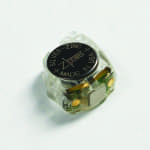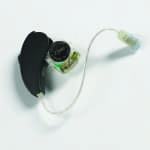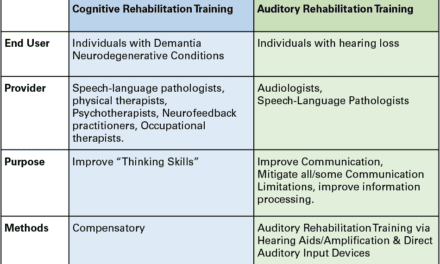Tech Topic | August 2015 Hearing Review
This article describes a new silver-zinc rechargeable battery system that is located in a battery door that can be retrofitted into many popular hearing aids. The ZPower Rechargeable Solution is designed to be powered for a full day even with wireless technology, have no effect on the electroacoustics of the instruments, help resolve the vision/dexterity concerns of patients, and be more environmentally friendly.
Following the Consumer Electronics Show in January, Fortune magazine concluded “…the top tech need on the mind of most Americans isn’t sharper televisions, smarter watches, virtual reality glasses or connected refrigerators. It’s better batteries.”1
This shouldn’t be a surprise to those of us in hearing care. Prior to the introduction of power-draining wireless and streaming hearing aids, Kochkin reported on the 2008 MarkeTrak VIII survey2 which showed that 45% of consumers rated the battery life of their hearing aids to be less than satisfactory and rechargeable hearing aids would increase the likelihood of new purchases.
Now, following the introduction of wireless streaming hearing aids, consumers in the 2014 MarkeTrak 9 survey3,4 named the “Most Compelling Features Sought” in order of importance:
1) Volume control on hearing aid;
2) A rechargeable hearing aid;
3) Program button for environments;
4) Rechargeable batteries for hearing aids.
Yet, today, only a relatively small number of rechargeable hearing aids are dispensed. In general, hearing care professionals say their resistance to rechargeable products include:
- “We don’t believe they are reliable.”
- “The charge doesn’t last long enough.”
- “The option is not worth the cost.”
- “They are not available in the products I use.”

Figure 1. Average capacity of #312 ZPower Silver-Zinc Battery (Red Line) compared to a commercially available rechargeable Nickel Metal Hydride Battery (Blue Line). The ZPower rechargeable AgZn #312 hearing aid battery has almost twice the capacity of tested rechargeable NiMH batteries.
Listening to these comments, ZPower began working with hearing aid manufacturers in 2007 to integrate silver-zinc (AgZn) rechargeable batteries into hearing instruments. As a company, ZPower was founded in 1997 to investigate commercial uses of rechargeable silver-zinc batteries.
Historically, silver-zinc batteries have been used in aerospace and for military applications, such as naval craft, missiles, and space vehicles.

Figure 2. Average capacity of #13 ZPower Silver-Zinc Battery (Red Line) compared to commercially available Nickel Metal Hydride Battery (Blue Line). The ZPower rechargeable AgZn #13 hearing aid battery has almost twice the capacity of tested rechargeable NiMH batteries.
As shown in Figures 1-4, when compared to other rechargeable technologies (eg, nickel metal hydride and lithium-ion), silver-zinc chemistry has the advantages of:
1) High energy density;
2) Cell potential less than 2 volts;
3) Safe, water-based chemistry similar to zinc-air;
4) Easily scalable to existing hearing aid battery sizes, and
5) Recyclable (Figures 1-4).

Figure 3. Discharge curves of ZPower Silver-Zinc versus commercially available Nickel Metal Hydride #312 Batteries. The NiMH battery loses voltage and current after approximately 10 hours; the AgZn battery retains capacity throughout the 18 hours of testing.
In the past few years, hearing aid manufacturers have primarily focused their technology roadmaps on wireless products. While these have been commercially successful, they also contribute to high battery drain and shorter battery life.
Most professionals and patients have noticed that, while batteries used to last a week or two, now they often last only a few days.

Figure 4. Energy density comparisons of 3 leading rechargeable chemistries (Nickel Metal Hydride, Lithium-ion, and Silver-zinc) for three sizes of batteries used with hearing aids. *Note: Lithium Ion data is projected because currently it cannot be scaled down in size for smaller batteries.
If these were the days before patients had access to the Internet or big box retail stores, then this would have been good news for retail battery sales. However, 80% of current patients purchase batteries outside the practice, and a reported 56% of audiology and dispensing practices currently offer a one-year or more supply of batteries with the purchase of hearing aids (Freeman et al, Battery survey of clinical practices; unpublished data, 2015). At this rate, it is estimated that hundreds of millions of new hearing aid batteries are bundled into the wholesale and retail costs of hearing aids and are dispensed for “free” annually in this country.
A New Rechargeable Solution

The new ZPower door regulates the voltage of the battery and has charging pins that are compatible with the contact charger (Figure 5a). The replacement battery door is installed exactly like a standard door, and it has no effect on the firmware or electronics of the hearing aid (Figure 6). The charging contacts (Figure 5b) allow the battery to be charged inside the hearing aid using the charging cradle (Figure 5c).

Figures 5a-c. Top and middle: Battery door with electronics to convert new and existing hearing aids and make them rechargeable. Bottom: Charging cradle for the rechargeable hearing aids.
The patient never has to open the battery door except once per year to replace the ZPower rechargeable battery. However, if the patient forgets to charge the battery, the hearing aid will still work with a disposable zinc-air battery.
Access to rechargeable hearing aids provides a value proposition to the patient, the practice, and the environment. Patients in ZPower clinical trials report:

Figure 6. Example of frequency response at 60 dB input (ANSI 2003) with signal processing algorithms turned on (left panel) and off (right panel) with wireless RIC hearing aid. There was no difference between the three battery types. ZPower AgZn batteries at both upper and lower plateaus performed comparably to standard zinc-air batteries.
Improved user experience. After completing the clinical trials, the majority of patients did not want to exchange the rechargeable hearing aids and return to using disposable zinc-air batteries.
Full-day of usage on a single charge. Figures 7-8 are examples of typical patient utilization during clinical trials with the ZPower Rechargeable Solution.

Figure 7. Example of actual wear time of a patient in clinical studies who was wearing a commercially popular wireless BTE hearing aid fit with the ZPower Rechargeable Solution. The Blue bars represent wear time during 24 hours; the green bars are charge time when patient is not using the hearing aid; the Yellow bars represent dormant time between full-charge and wear time. This subject in the clinical trials used the rechargeable system an average of 17-18 hours/day which required an average of 3-4 hours to recharge.
Patients were able to use their aids for a full day (in some cases 24+ hours) even with wireless streaming, recharge in 3-4 hours, and still have remaining capacity.
Patient retention through annual replacement. One ZPower rechargeable battery is needed per hearing aid each year. The silver-zinc battery is equivalent to an estimated 100 zinc-ar batteries. It will last for a full year and the patient can purchase a replacement at the clinic.

Figure 8. Example of wear time and remaining capacity. Patients in the clinical trial had an average wear time of 14+ hours and at the end of that time, the hearing aids had an average of 70-80% remaining capacity indicating that wear time for the typical ZPower silver zinc rechargeable battery would easily accommodate an average day with wireless hearing aids and streaming.
In addition to positive experiences by patients, the new rechargeable silver-zinc battery offers the professional the opportunity to differentiate their practice by offering unique technology. Patients must purchase replacement batteries annually at the practice which maintains patient relationships and creates “patients for life.”
Finally, there is a significant environmental value of adopting the ZPower silver zinc battery. It is estimated that 1.5 billion zinc air hearing aid batteries are sent to the landfill annually. In contrast, the silver zinc battery is fully recyclable and an estimated 100 disposable zinc-air batteries can be replaced by a single silver zinc battery.
Rechargeable battery technology for hearing instruments meets the demands of hearing care professionals by allowing the hearing aid to be powered for a full day even with wireless technology; is available in the products most often fit; has no effect on the electroacoustics of the instruments; resolves the vision and dexterity concerns of patients; and is environmentally friendly.
References
-
Murray A. What do consumers want? Better batteries, not wearables. January 27, 2015. Available at: http://fortune.com/2015/01/07/what-do-consumers-want-better-batteries-not-wearables
-
Kochkin S. MarkeTrak VIII: The key influencing factors in hearing aid purchase intent. Hearing Review. 2012;19(03):12-25. Available at: https://hearingreview.com/2012/03/marketrak-viii-the-key-influencing-factors-in-hearing-aid-purchase-intent
-
Abrams HB, Kihm J. An Introduction to MarkeTrak IX: A New Baseline for the Hearing Aid Market. Hearing Review. 2015;22(6):16. Available at: https://hearingreview.com/2015/05/introduction-marketrak-ix-new-baseline-hearing-aid-market
-
Better Hearing Institute (BHI). MarkeTrak 9. Washington, DC: BHI;2015.

Correspondence can be addressed to [email protected]
Original citation for this article: Freeman, B. A New Door to Rechargeable Hearing Aid Battery Solutions. Hearing Review. 2015;22(8):22.?







I purchased a pair of Sturkey RIC hearing aids in October of 2017.
2 weeks ago, the battery in one weakened and then quit. I have the Z Powersystem for (mRIC312t}with the aids.
The one battery failed in 7 months.
Your article says to expect 1 year of life
so I am not happy with the product.
I had previously commented to my breakfast(mostly engineers} on the life and convenience of the system.
I cannot find the replacement batteries on the webb and do not see your price listed
on the webb.
The drop in charger is great but the batteries aren’t available and don’t last.
Will try the standard 312 batteries for a
few months till the remaining battery fails
while looking for a rechargeable replacement.
Evan
Evan
Thank you for an informative post about a new silver-zinc rechargeable battery system. Having the same question with Mike: Can the rechargeable battery be charged outside the aid or must it be inserted in to the battery compartment?
Will these be suitable for a Siemens rechargeable hearing aid that uses nicads or zinc air 312s
If so would your charger also dry the hearing aids as does the Siemens charger. Really keen on this. Email me when available in USA if suitable.
An excellent analysis. Hearing aids need to be heard good, as most people use closed hearing aids, which are inside the cochlea, so it’s a complicated process to take it, so they care battery, the good battery will limit the change, recharge.
Thanks for the useful article.
My life is depending on hearing aid, that’s why I always dream of rechargeable battery for it. Thank you for this useful post!
“This article describes a new silver-zinc rechargeable battery system that is located in a battery door that can be retrofitted into many popular hearing aids.” a great article with a lot of interesting to know, thanks for sharing
Your post is really helpful for those who is in need of a good hearing aid battery.
Moreover, what if I forget to charge my hearing aid? Can I use a standard battery instead in that case?
Thank you for your nice post.
Yes it says that this is the case in the event that your forget to recharge it. Very handy indeed!
Informative article.
Your post is really helpful for me, thanks a lot.
Please email me when you have re-chargeable 312 hearing batteries and a solution for re-charging size 312 hearing aid batteries. ([email protected])
Hello, Barry Freeman, PhD! Nice post about hearing aid battery solutions! Especially your important information: Volume control on hearing aid; a rechargeable hearing aid; program button for environments; rechargeable batteries for hearing aids.
I wear my hearing aids inside my ears. Is there a battery charger for that type of
hearing aid? (I have to take my batteries out of the hearing aids.)
Nice informative post – recharging the battery is a must.
Great. Now I can find a solution to the problem of my rechargeable hearing aid battery.
Very informative article about battery. Thanks
Interesting article.
Just one question.
If, as the article states, the user forgets to recharge the battery and replaces it with a standard battery, can the rechargeable battery be charged outside the aid or must it be inserted in to the battery compartment?
Regards
Mike
Great and informative article. I agree that hearing aid batteries won’t last and need re-charging. So to be on the safe side, it’s best to always have a spare battery in hand just in case the battery in use goes out of power.